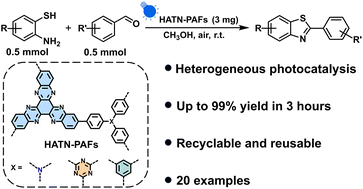Porous aromatic frameworks (PAFs) are considered as promising photocatalysts for efficient organic transformations. In this study, the synthesis of donor–acceptor (D–A)-type hexaazatrinaphthylene-based porous aromatic frameworks (HATN-PAFs) is presented. By linking HATN units with other different fragments, the surface areas, bandgaps, energy levels and photoelectric properties of HATN-PAFs could be easily tuned. Notably, the combination of HATN with triphenylamine (TPA) fragments facilitates photoinduced charge separation and migration, and reactant transport and activation during photocatalysis, which achieves high yields (up to 99%), an expandable substrate scope (20 examples), and good recyclability (up to 10 cycles) for the photosynthesis of 2-benzothiazoles under an air atmosphere upon excitation by a blue LED light (460 nm, 24 W). This photocatalytic system does not require additional oxidants or metals, making it environmentally friendly. A mechanistic study reveals that the simultaneous generation of the reactive oxygen species O2˙− and 1O2 over this catalytic system may jointly accelerate the oxidative formation of 2-benzothiazoles.


